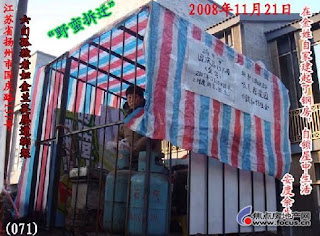Sunday, November 1, 2009
1+3
Residential blocks of historical and traditional architecture are being torn down in center of my hometown of Yangzhou, being replaced by commercial buildings as the city tries to market itself towards comteporary tourists in an attempt to increase revenue, while residents are forcibly relocated to newly developed satellite cities.
These residential blocks must be protected and renovated, using sustainable methods that are able to increase the living comfort of residents at minimal costs, to preserve the rich culture of Yangzhou and allow tourists to experience the true culture of the city, not an artificial facade created by the government.
In addition to renovation, housing units themselves should be spatially and programmatically modified to provide safety, comfort, and accessibility to the elderly residents, who make up most the occupants and are growing in number in recent years, and in the future, encourage younger generations to live there.
Tuesday, October 20, 2009
Architecture can bring about better living conditions in older neighborhoods in China while preserving the history, culture, and heritage of that place through acceptable social and economical means.
Demolition of older residential blocks is common place in many smaller Chinese cities today. Although these residential blocks have historical and cultural value, they are seldom maintained well by residents. The government has no qualms about tearing down these housing blocks in the city core and replacing them with commercial buildings as the city slowly loses its residents as well as its culture.
Occupants of these older neighborhoods are relocated to newer residential areas, far away from the city and its amenities. Resistance leads to force, as older members of the residents are forced to leave houses they have lived in for their entire lives. The government has the resources and manpower to renovate these older housing blocks. Most of these residential blocks can be reprogrammed and reorganized to suit the modern lifestyle of the occupants. Handicap accessbility, stormwater drainage, and fire-resistance are just a few things that can be improved.
Sustainable passive and active strategies can increase the living comfort of residents at minimal costs. Most of the people living in these older blocks are the elderly, and not enough is provided for them in these housing conditions. Renovations to these blocks are also encourage younger generations to live there. These housing blocks are capable of becoming self-sustaining communities public amenities and small commercial areas within them.
Tuesday, September 22, 2009
The Impact of Urban Development

Monday, September 21, 2009
Site Matters: Behind the promises of a new development, lies a disturbing reality

Monday, September 14, 2009
The Muses are Not Amused
In most studio projects, we were given a program beforehand and we interpreted the function. The program stays the same, while the function changes due to environment, society, culture and time. Predicted function is not always the actual function (if it functions) when constructed. Time and place are the most important aspects when talking about function. A park in 1940 functions much differently than one today, and a park in China functions much differently than a park in the US. Although the program is the same, the type of actions occurring in each one in different. Focusing solely on the program and disregarding place and time has the danger of succumbing to the idea that the form of such a program supposedly "induced the ‘actions’ promoted by the program."
Silvetti defines "thematization for living" as the "operation of mimicking a well known architecture and the promise that such architecture will deliver a predetermined, good way of life." This idea is prevalent in the misconceptions of Chinese people today. Because of centuries of crowed living environments and substandardized living conditions due to the enormous population, Chinese people today view the Western single-family house or villa as the ideal home. As a result, not only is the housing typology seen as a symbol for better life, but the architectural style itself. A prime example is in the city of Changsha, in the Hunan province, where a huge residential development has started in the summer of this year.









